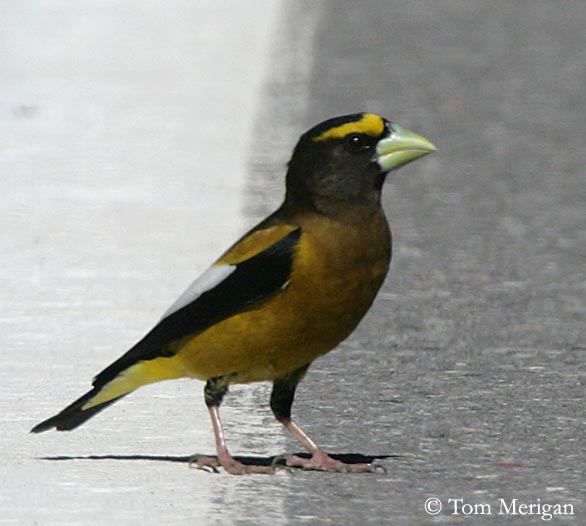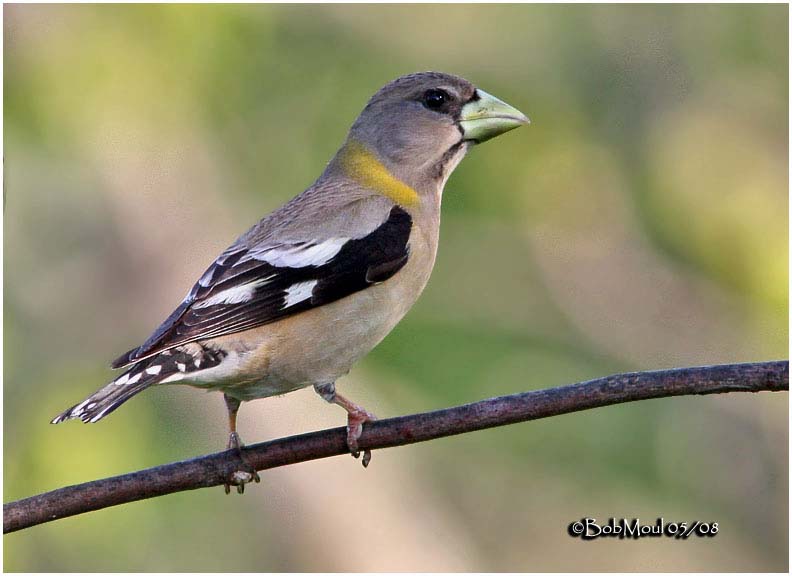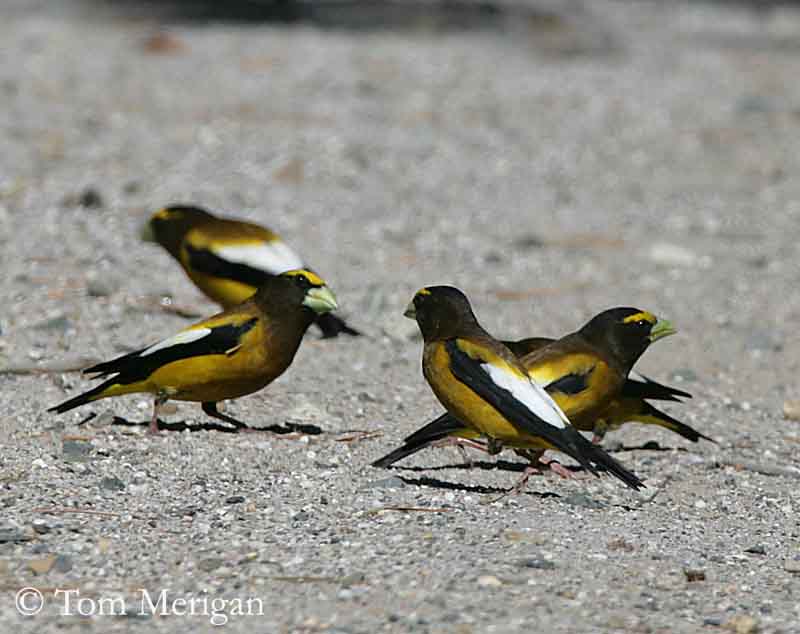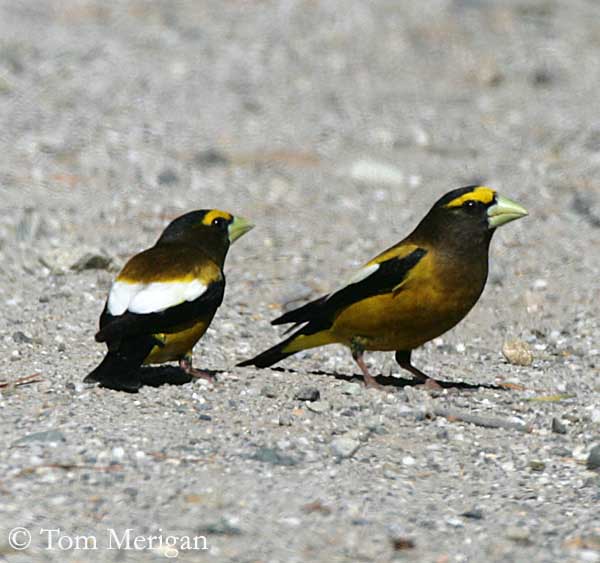
Evening Grosbeak
Hesperiphona vespertina
Passeriforme Order – Fringillidae Family
BIOMETRICS:
Length: 16-18 cm
Wingspan: 30-36 cm
Weight: 53-74 g
LONGEVITY: up to 15 years
DESCRIPTION:
Evening Grosbeak male is a plump bird.

Its beautiful plumage shows golden yellow body feathers, with a gold band across forehead. It has a conspicuous white patch on the upperwing.
Underparts are yellow. Tail is jet black, as the flight feathers.
Crown and neck feathers look like rich brown velvet, and show some glossy effect.
Prominent bill is cone-shaped, pale yellow in winter and greenish yellow in spring.

Adult female has silver grey body, with some yellow on the sides, nape and rump. Tail and wings are black with white patches. Underparts are pale grey, with buffy and silvery white chin and undertail coverts.
Immature has dark areas on shoulder patches.
VOICE: SOUNDS BY XENO-CANTO
Evening Grosbeak is a bad singer. Its usual voice consists of a single screaming note. When it tries to sing, the note is a single warbling call.
Its typical call is a ringing “chirp” or “cleer”, and a loud “cleep” call. This cry is used by each bird to proclaim its place in a flock.

Evening Grosbeak is a noisy bird and has numerous calls. It has a wide miscellany of sounds to tell all its feelings.
HABITAT:
Evening Grosbeak prefers thick conifer and spruce forests, but now, it has adapted to mixed deciduous woodlands.
It breeds in conifer or mixed forests, but it winters in deciduous woodlands, suburban areas and semi-open countries.
RANGE:
Evening Grosbeak breeds from SE Yukon, southward to N California and Rocky Mountains into Mexico. Local populations breed in South Dakota and Saskatchewan, and eastward in Newfoundland and Northern United States.
To winter, northern populations abandon their range to southern United States. Their numbers vary every year. They are erratic migrants in winter.

BEHAVIOUR:
Evening Grosbeak is very gregarious, forming large flocks in winter, up to 100 to 300 individuals.
Evening Grosbeak eats sunflower seeds, and it has specific manner to eat them. This bird has a large tongue. After it cracks a seed open, it uses its tongue to scoop out the seed and swallows it directly. They can clean out a large amount of sunflower seeds in a very short time. “A single bird may eat 96 seeds in five minutes”.
Evening Grosbeak feeds in the tree top on the seeds of the sugar maple. It also eats buds with other birds. This species devours big quantities of raw salt, salt-impregnated earth, and fine gravel also interests it.
Evening Grosbeak feeds also on budworms. They feed on large number of the larvae and pupae, and parents feed their nestlings with this pest food.
Outside the breeding season, Evening Grosbeak feed in flocks.
During courtship display, male crouches low, puffs out its feathers, and extends and quivers wings. Mates bow from each other. Female calls during display, and occasionally male feeds her. Male may dance in front of female with dropped and vibrating wings.
Evening Grosbeaks like to wander erratically. They perform southern movements caused by periodic food shortages.
FLIGHT:
Evening Grosbeak’s flight is undulating. It performs rapid wing beats, displaying its white wing patches. It often calls in flight.
REPRODUCTION:
Evening Grosbeak’s nest may be located in spruces or deciduous trees, at about 6 to 12 metres high. Nest is usually built by female. It is made with small twigs, and lined with grass, rootlets, moss, or fibrous bark and horse hair. It is a shallow loose cup, built on a horizontal branch or in a vertical fork of a tree.

Female lays 3 to 4 pale greenish eggs, lightly spotted with pale brown. Incubation lasts about 12 to 14 days, by female fed by the male during this period. Chicks are altricial, hatching helpless with sparse down. They are fed by both parents. Young fledge at 13 to 14 days after hatching.

DIET:
Evening Grosbeak feeds on a wide variety of small fruits and seeds (mainly sunflower seeds) and maples sap.
It also feeds on insects and invertebrates, buds, spruce budworms larvae and pupae (Choristoneura fumiferana).
PROTECTION / THREATS / STATUS:
Evening Grosbeak is a beneficial bird because it feeds on destructive pest such as budworms. It may eat 1000 a day!
Evening Grosbeak is abundant and widespread.
Fr: Grosbec errant
All: Abendkernbeisser
Esp : Pepitero Vespertino
Ital: Frosone vespertino americano
Nd: Avonddikbek
Sd: Aftonstenknäck
Photographs males by Tom Merigan
His website:
Tom Meriganís Photo Galleries
Photographs females by Bob Moul
His website:
Nature Photography
Text by Nicole Bouglouan
Sources :
FIELD GUIDE TO THE BIRDS OF NORTH AMERICA - National Geographic Society - ISBN: 0792274512
All About Birds (Cornell Lab of Ornithology)
Bird Web (Seattle Audubon Society)
What Bird-The ultimate Bird Guide (Mitchell Waite)
Wikipedia (Wikipedia, The Free Encyclopedia)
South Dakota Birds and Birding (Terry L. Sohl)
Birds of Nova Scotia (Robie Tufts)